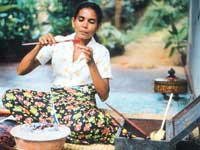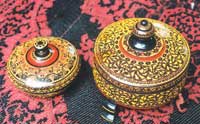| Plus |
|
|||
|
Living
memory in lacquer
Intricate designs in lacquer on hara miti, bastham, sesath sticks and poth khamba or pirith book covers, for which the most important tools are the fingernails – that's what the remote village of Pallehapuwida set amidst the beautiful hills and valleys of Matale is famous for. "We use the thumbnail of the left hand and the nail of the right sulangilla (tiny finger) to create beautiful patterns in this industry passed down to us from our ancestors," says Mahawelige Rajakarunatillekeratnelage Karunaratne, 78, with justifiable pride explaining the village's speciality. Delving deep into the intricacies involved in lacquer, or laaksha (as he calls it), Karunaratne says Agulmaduwa in Matara is well known for simple laaksha mosthara on toys and Hurikaduwa in Maha Nuwara for drums such as udekki painted with the liyawela. "But it is Matale's Hapuwida which is famous for lakada walin kendi adala pattern eka ganna ekata." When the pattern goes slightly awry, the fingernails are once again used to right the wrong. "The complicated but exquisite patterns on one of a pair of pirith book covers take about 15 days, if I sit the full day at it," he says, while instructing his daughter, Yamuna Kumari on how to get the "padama" (right consistency) for the lakada. Having been at the side of her father since she can remember, 40-year-old Yamuna, one among nine brothers and sisters, is following the paarampaarika (traditional) laaksha work, like Karunaratne, his father and his grandfather before him. Of the 320 families in Pallehapuwida, about 184 families are directly involved in this trade. Most of the others give a helping hand. "We can say about 99% are part of this industry," says Karunaratne. This industry in Pallehapuwida has its roots embedded in history, he says, tracing it back to 1635, the time of King Rajasinghe II. The king had sent out a royal edict through the anda berakaru, from village to village, that he wanted mura ayuda, window panelling and kitchen utensils with lacquer work for his palace. A man named Pusappu, in a far-flung village in the Kandyan kingdom stopped the king's messenger and said he could do the job. "Pusappu
was my muththa going back nine generations," says Karunaratne. When taken to the palace to meet the king, Pusappu had been asked what he required. The ideal raw material he found in an area called Nihabepola Wella Dolouna. On delivering the goods, the King had been so pleased with Pusappu's work that he had issued a sannasa for him and his clan to settle in the area. Thus accompanied by 30 people from the King's household and 30 from Pusappu's village, along with as many gifts as they could carry, with an athinna (cow elephant) named Hapi thrown in for good measure, Pusappu had set off for that village. As they entered
the village, weighed down by royal gifts, Hapi had walked to a waterhole
near a rock and sprawled out comfortably. When the naming of the
village had to be done, recalling the first action of the cow-elephant,
the people had decided to call it Hapihida (where the elephant lay
down), which later became Hapuwida. Because there was a village
on the hill above, it had finally been called Pallehapuwida. How his ancestors and even Karunaratne in his heyday got the colours is a fascinating revelation. The men would forage in the jungle in November and December for the tiny nests of the laaksha insect found on twigs. To prevent harm to this miniscule insect, which Karunaratne says is about 1/16th the size of an aba ate (mustard seed), the men would cut some of the tree branches and let them hang down. "Fearing that the tree was dying the insect would move to another, allowing us to scrape the tiny nests off without harming them," he says. The nest is the size of a coffee bean and a full day in the jungle would yield only about two serus of what they dubbed "bora" lakada as it had impurities in it. The men would take this prized collection to the village, wash it thoroughly in a sieve, dry it and send the contents, once again, through the lakada penduwa. The final product kept as the "maw (mother) lakada" is brownish in colour. Small pieces of the "maw lakada" are heated up and two sticks used to "kahata adinna" (pull out threads) and work the main pattern. The colour given out by these threads is golden. To fill in the other primary colours such as red, yellow and blue, minerals or stones were crushed. Black came from the soot that settled on the sides of a lamp when a banana leaf was held over the flame. "These colours lasted hundreds of years," says Karunaratne, adding that now imported dyes are used because the earlier processes were tedious and complicated. "We ask our customers what they want, whether they prefer the old colours. That would cost more but last longer." Some of the raw material, collected by him decades ago, had been removed by people who came to study and research this ancient trade, he laments. Keeping an eye on daughter Yamuna pulling the lakada threads he laughs, "If the heat is too hot it will melt, if it is too cold it will go waste. It has to be just right. If you make a mistake you burn your fingers." The income from their backbreaking work is sufficient to keep the home fires burning, he says censuring the young ones "who have got into trousers" and are reluctant to sit on the floor at this task for the whole day. Now more and
more machine-painted stuff is flooding the market, he grumbles. |
||||
Copyright © 2001 Wijeya Newspapers
Ltd. All rights reserved. |

